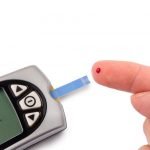The Wrong Target: The Fallacy of Using Hypoglyemic Agents in Diabetes
Richard K. Maurer, ND
Follow the Money
I remember the scene from All the Presidents Men: Robert Redford, as reporter Bob Woodward, is in the parking garage awaiting a critical meeting with “deep throat” to make sense out of the as-yet-named Watergate scandal. I imagine this scene every time I see a patient who, at the advice of their prescribing physician, is on 2 or more medications to lower blood sugar. The scene is terribly suspenseful, scary actually, yet it involves nothing but dialogue; I refer, of course, to both the doctor’s office and parking garage. Robert Redford, unlike the prescribing doctor, does arrive at the truth when he says, “He’s got a lawyer with $25,000 in a brown paper bag…” and is interrupted by his informant with an urgent hint to “Follow the money!”
That’s it. Those 3 words were enough to encourage the reporters, Woodward and Bernstein, at the Washington Post toward the truth. What, you might ask, are the doctor and patient supposed to do with these words to resolve and correct high blood sugar? And why do I suspect that most doctors, in all likelihood, are not as clever or gutsy as the now-famous Washington Post journalists?
Smoke and Mirrors
Conventional medical treatment of type 2 diabetes and the “pre-“ states, which include metabolic syndrome and prediabetes, is an act of smoke and mirrors. Insulin resistance and the resultant states are ICD-coded and labeled as grave, degenerative diseases that require medical correction.
In truth, insulin resistance is a perfect expression of an efficient calorie economy; inappropriate lifestyle habits are the disease. Life habits need to be in accordance with one’s genetic expression.
I appreciate how difficult it is to see a positive aspect of the traits behind type 2 diabetes, a condition that is clouded by 1-sided headlines that negatively fixate on the end-stage disease in overmedicated or uncontrolled type 2 diabetics. If I hadn’t seen thousands of people effectively turn their insulin resistance around—reversing weight problems, high blood pressure, lipid abnormalities, low energy, and type 2 diabetes—I, too, might lack the confidence and positive attitude that I maintain toward insulin resistance.
Let me stretch the movie analogy 1 more step: Your glucose is the cash in the brown paper bag. To expose the truth about type 2 diabetes and high blood sugars, fatty liver disease, and insulin resistance, you need to divine your inner Redford and “follow the money.” And if, after taking a drug or herb, the glucose from the meal is not in the bloodstream, where did it go?
Your blood glucose is the cash in your hands.
Glycogen is the money deeper in your pockets.
Body fat and triglycerides represent the money stored in your bank account.
The villains’ trick, in any scandal, is to hide or distribute the evidence, in this case the cash, so that it is not seen or found. The villains in the doctor’s office are the drug therapies that lower blood sugar. If you are a practitioner, you have to be the truth-seeking reporter; and hey, Dustin Hoffman and Robert Redford are not bad role models. If you are the patient, you need to seek your own truth—track the evidence and learn something about your unique metabolic blood tests.
There are people who believe that oral hypoglycemic drugs – medications that lower blood sugar – are “life-saving” medications. But are they really?
Lessons Learned From the ACCORD Trial
In a large-scale study called the ACCORD trial, published in the New England Journal of Medicine in 2008,1 type 2 diabetics were divided into groups to compare more-aggressive combined drug therapy to lower blood glucose levels to as close to normal as possible (the goal was <6% HgA1C). However, the study did nothing to emphasize diet and exercise; instead, researchers were going to use what most doctors use already, ie, “polypharmacy,” or many different drugs in each person as needed to lower sugars. Two drug classes represented most of the test subjects. Biguanides, such as metformin, are a drug class that lowers blood sugars by supporting the cellular uptake of glucose and preventing the release of stored glucose. Sulfonylureas, such as glipizide or glyburide, are a class of drugs that stimulate the release of insulin; higher insulin means lower blood sugar, at least temporarily. Other drug classes, with cool-sounding acronyms like TZDs, DPP-4 and GLP-1, have the same end-result as the sulfonylureas—they stimulate the release of extra pancreatic insulin. Another therapeutic treatment in this study included the direct injection of insulin, which, of course, effectively lowers blood glucose by raising the level of circulating insulin.
But, the trial, planned for 5.6 years, was discontinued after 3.5 years because the people on more-intensive drug protocols were dying far more rapidly than the controls, even though they had lower average blood sugars, as measured by HbA1C. The lead author, Dr Hertzel Gerstein, explained the incriminating findings: “We believe that some unidentified combination of factors tied to the overall medical strategy is likely at play.”2
Overall medical strategy means that the entire concept of drugging the body into metabolic submission (lowering blood glucose was the only goal of therapy) kills more people than it cures. Blood glucose isn’t the culprit; rather, the process of insulin resistance is the culprit. The people in the aggressively treated group took tricky medications that raised blood insulin levels, thereby hiding the blood glucose – the “money.” This trick ultimately makes the problem worse by exacerbating insulin resistance. Drug-induced high insulin, just like innate high insulin, promotes fat gain, fluid retention, even more insulin resistance, and blood sugar irregularities. People in the ACCORD trial were not instructed to reduce their carbohydrate intake. Health principle: The medical-industrial-pharmaceutical system has no vested interest in advising individuals to prevent or reverse disease through lifestyle.
Drug Mechanisms
So let’s help you understand the mechanisms of these 2 main tricksters. Biguanides, like metformin, do not raise insulin. Biguanides have 2 actions: one is to facilitate cellular uptake of glucose from the bloodstream; drug claims inflate this action and state that the drug makes the cells more sensitive to insulin. This class of medications has another action, which is to prevent the release of stored sugars from your cells, especially from the liver. Your glucose is a quick energy source – explosive, like gasoline. Let’s follow the biguanides’ action through: You take metformin → then you eat a carbohydrate-rich meal like oatmeal → your body rapidly throws the post-meal sugars out of the bloodstream and into storage, especially in the liver → then the cells are locked shut such that the body can’t see or release the stored glucose. A closet full of gasoline is a fire hazard, and locking the door does not remove the risk.
A few metformin studies exemplify the adverse conditions that result from its mechanism of action. Metformin interferes with exercise performance3; this is not surprising because the drug prevents the important release of sugar that is stored as glycogen in your muscles and liver. The drug has been linked to higher heart rates and more subjective fatigue under exercise conditions.3 The researchers absurdly cited this as a reason that people on metformin might need to work out less strenuously. It’s inane, as exercise works as well if not better than metformin to control blood sugars.4 Furthermore, strenuous exercise improves underlying insulin resistance better than metformin.5
The other, even more villainous, tricksters are the drugs that raise insulin levels, like the sulfonylureas, to lower blood glucose. Remember, insulin resistance is the real problem. Adding more and more insulin does temporarily lower blood glucose, by stimulating the manufacture and storage of fat from circulating glucose. And, like metformin, elevated insulin prevents the release of stored sugar and fats from our muscles and liver. This problem is exemplified in studies that show “highly significant” weight gain while on these drugs.6
Herbal Extracts as Potential Tricksters
Berberine extract: Berberine is the extracted alkaloid from the Oregon grape/barberry (Berberidaceae) family of plants. It has potent hypoglycemic effects, and beginning around 1990, was confirmed as a useful substance to lower blood sugar, while also lowering insulin and central body fat distribution. It has won a reputation for being “like metformin,” the common first-line drug for type 2 diabetes.7
The mechanism for berberine extract is unclear. For decades it has been a well-researched herbal treatment for intestinal infections like giardiasis, but it comes with the warning to avoid long-term use due to the potential undesirable side effects and antimicrobial effect in the gut. Berberine is not well absorbed; it therefore acts primarily within the gut, causing malabsorption of glucose.8 In type 2 diabetes studies, over 30% of the subjects that took berberine sulphate had side effects including digestive distress, nausea, and diarrhea.9 The frequency of gastrointestinal side effects reinforces how the herb likely works to reduce blood sugars: by creating malabsorption, dietary nutrients go right through.10 It is better to put less carbohydrate in your mouth than to take a drug that causes gastrointestinal irritation and interferes with nutrient absorption.
Cinnamomum cassia (cinnamon): More than a few studies have negated the initial hype about using cinnamon to reduce blood sugar. While the polyphenolic extract of cinnamon does show some minor beneficial effects, albeit questionable, there no harm in using a teaspoon of cinnamon with food on a daily basis.
Gymnema sylvestre: An herbal extract from the leaf of this traditional Ayurvedic plant is found in nearly every “diabetic support formula” on the market. This herb undeniably reduces blood sugar. But how does it work? It triggers the release of more insulin.11 Since this is the very problem you are trying to avoid, and since other drugs that raise insulin are associated with long-term complications and death in type 2 diabetics, this herbal extract is not part of a patient’s long-term metabolic cure.
Panax quinquefolius (aka American ginseng): Researchers have shown that high doses of Panax ginseng extract, when used before a high-carb meal, reduce blood sugar in the hours after the meal. Again, sounds interesting, right? This is a similar effect to that found with alcohol. The sugar is still ingested, so if it isn’t in the bloodstream right away, where is it? Did it quickly get turned into fat or glycogen? Is the glucose now in your liver? When nondiabetics took Panax ginseng well before a meal, their blood sugars dropped substantially. Like Gymnema, the primary hypoglycemic mechanism of Panax ginseng is to raise insulin. Remember: Insulin resistance and high insulin, not high blood sugar, is the problem behind heart disease and diabetes. Panax ginseng is a very interesting herb with many diverse effects, but it shouldn’t be part of a long-term plan to control high blood sugars.12,13
Nutritional Therapy
What about nutritional therapy? It is true that once insulin resistance is present, cellular nutrient deficiencies, especially magnesium, are likely contributing.14 The primary nutrients that facilitate healthy insulin response are magnesium, vitamin D, vitamin K, and chromium. Deficiency should be prevented, but at above-repletion doses, benefit appears minimal.
For example: Experimental data have shown that vitamin D improves insulin resistance, exerts anti-inflammatory actions, and is important for glucose-induced insulin secretion. The link between low vitamin D in the bloodstream and stroke, heart attack, and high blood pressure is remarkably well-established.15,16The strong association between low vitamin D and the development of insulin resistance and type 2 diabetes is also crystal clear,17 but this relationship is not exactly cause and effect. Despite the mass of associative data, numerous studies reveal a failure to “cure” insulin resistance with short-term use of high-dose supplemental vitamin D; thus, mere vitamin D supplementation is not a magic bullet.18
Chromium follows the same story. Chromium deficiency results in insulin resistance; it follows that high-dose chromium supplementation was thus touted as a cure for obesity and diabetes for decades. However, comprehensive studies have failed to show any blood sugar improvements or weight loss with high dose (>200 mcg) chromium supplementation.19 A review of all placebo-controlled studies fails to reveal glucose improvement or heart disease risk reduction.20 So why is chromium in every diabetes and blood sugar protocol on the market? Because, inarguably, studies continue to show that if you are deficient in chromium, you are at high risk of insulin resistance and associated heart disease.21 A little bit of chromium, eg, 50-100 mcg, is likely adequate to help someone move toward insulin sensitivity.
Conclusion
The profligate use of drugs to lower blood sugar is a medical “Glucosegate.” Those of us in the realm of natural medicine must, too, open our eyes to the way we help patients cure and resolve their condition of insulin resistance and type 2 diabetes. Follow the money. Many physicians are reluctant to reduce oral hypoglycemic medications because they assume that their patients will be more compliant with a pill than with meaningful carbohydrate restriction and an appropriate strenuous exercise routine. Medical advice must not be based upon a patient’s presumed failure. Pill-for-a-problem healthcare is limited at best and harmful at worst. As healthcare providers, we must model and project the profound healing potential that comes from well-indicated and supported dietary and fitness habits.
 Richard K. Maurer, ND, author of The Blood Code (2014), has practiced integrative medicine in Maine since 1994, when he graduated from NCNM in the other Portland. He helps people interpret their unique blood test results. His own personal and familial trend toward type 2 diabetes has only strengthened his preventive and natural medical pursuits in an effort to help others find their effective dietary, nutritional, and fitness habits.
Richard K. Maurer, ND, author of The Blood Code (2014), has practiced integrative medicine in Maine since 1994, when he graduated from NCNM in the other Portland. He helps people interpret their unique blood test results. His own personal and familial trend toward type 2 diabetes has only strengthened his preventive and natural medical pursuits in an effort to help others find their effective dietary, nutritional, and fitness habits.
References
1. Action to Control Cardiovascular Risk in Diabetes Study Group, Gerstein HC, Miller ME, et al. Effects of intensive glucose lowering in type 2 diabetes. N Engl J Med. 2008;358(24):2545-2559.
2. National Heart, Lung, and Blood Institute; National Institutes of Health. ACCORD Clinical Trial Publishes Results. June 6, 2008. NIH Web site. http://www.nhlbi.nih.gov/news/press-releases/2008/accord-clinical-trial-publishes-results.html. Accessed December 15, 2014.
3. Boulé NG, Robert C, Bell, GJ, et al. Metformin and exercise in type 2 diabetes: examining treatment modality interactions. Diabetes Care. 2011;34(7):1469–1474.
4. National Institutes of Health. Diet and Exercise Dramatically Delay Type 2 Diabetes. August 6, 2001. NIH Web site. http://www.nih.gov/news/pr/aug2001/niddk-08.htm. Accessed December 15, 2014.
5. Orchard TJ, Temprosa M, Goldberg R, et al. The effect of metformin and intensive lifestyle intervention on the metabolic syndrome: the Diabetes Prevention Program randomized trial. Ann Intern Med. 2005;142(8):611-619.
6. Campbell IW, Menzies DG, Chalmers J, et al. One year comparative trial of metformin and glipizide in type 2 diabetes mellitus. Diabete Metab. 1994;20(4):394-400.
7. Zhang H, Wei J, Xue R, et al. Berberine lowers blood glucose in type 2 diabetes mellitus patients through increasing insulin receptor expression. Metabolism. 2010;59(2):285–292.
8. Pan GY, Wang GJ, Sun JG, et al. Inhibitory action of berberine on glucose absorption. Yao Xue Xue Bao. 2003;38(12):911–914. [article in Chinese]
9. Yin J, Xin H, Je J. Efficacy of berberine in patients with type 2 diabetes. Metabolism. 2008;57(5):712–717.
10. Li ZQ, Zuo DY, Qie XD, et al. Berberine acutely inhibits the digestion of maltose in the intestine. J Ethnopharmacol. 2012;142(2):474–480.
11. Baskaran K, Kizar-Ahamath B, Radha Shanmugasundaram K, Shanmugasundaram ER.. Antidiabetic effect of a leaf extract from Gymnema sylvestre in non-insulin-dependent diabetes mellitus patients. J Ethnopharmacol. 1990;30(3):295–305.
12. Vuksan V, Sievenpiper JL, Koo VY, et al. American ginseng (Panax quinquefolius) reduces postprandial glycemia in nondiabetic subjects and subjects with type 2 diabetes mellitus. Arch Intern Med. 2000;160(7):1009–1013.
13. Park EY, Kim HJ, Kim YK, et al. Increase in Insulin Secretion Induced by Panax ginseng Berry Extracts Contributes to the Amelioration of Hyperglycemia in Streptozotocininduced Diabetic Mice. J Ginseng Res. 2012;36(2):153–160.
14. Volpe SL. Magnesium, the metabolic syndrome, insulin resistance, and type 2 diabetes mellitus. Crit Rev Food Sci Nutr. 2008;48(3):293–300.
15. Brøndum-Jacobsen P, Nordestgaard BG, Schnohr P, Benn M. 25-Hydroxyvitamin D and symptomatic ischemic stroke: An original study and meta-analysis. Ann Neurol. 2013;73(1):38–47.
16. Arnson Y, Itzhaky D, Mosseri M, et al. Vitamin D inflammatory cytokines and coronary events: A comprehensive review. Clin Rev Allergy Immunol. 2013;45(2):236-247.
17. Tsur A, Feldman BS, Feldhammer I, et al. Decreased serum concentrations of 25-Hydroxycholecalciferol are associated with increased risk of progression to impaired fasting glucose and diabetes. Diabetes Care. 2013;36(5):1361-1367.
18. George PS, Pearson ER, Witham MD. Effect of vitamin D supplementation on glycemic control and insulin resistance: a systematic review and meta-analysis. Diabet Med. 2012;29(8):e142–e150.
19. Masharani U, Gjerde C, McCoy S, et al. Chromium supplementation in non-obese non-diabetic subjects is associated with a decline in insulin sensitivity. BMC Endocr Disord. 2012;12:31.
20. Balk EM, Tatsioni A, Lichtenstein AH, et al. Effect of chromium supplementation on glucose metabolism and lipids: A systematic review of randomized controlled trials. Diabetes Care. 2007;30(8):2154–2163.
21. Rajpathak S, Rimm EB, Li T, et al. Low toenail chromium in men with diabetes and cardiovascular disease compared with healthy men. Diabetes Care. 2004;27(9):2211–2216.










